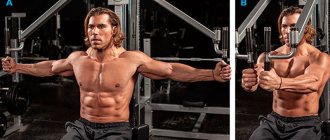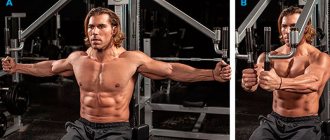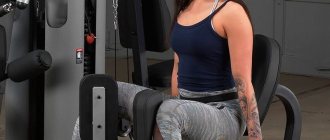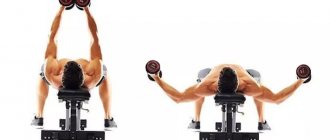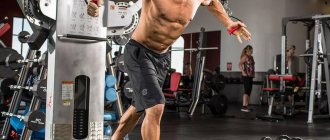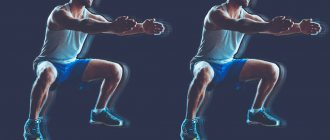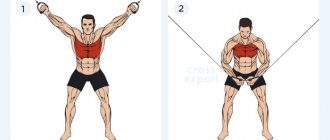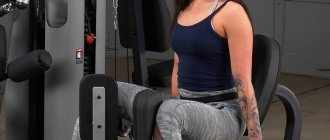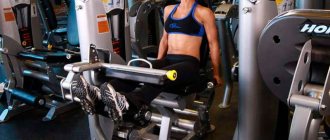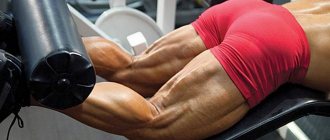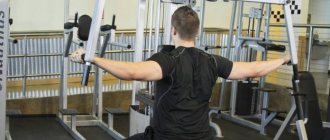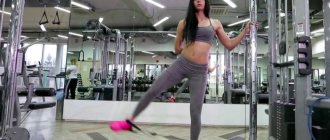The Butterfly exercise got its name due to the similarity of the athlete's hand movements to the flapping of a butterfly's wings. However, this analogy is conditional, since the ideal execution of the “butterfly” requires good physical training and experience in working with heavy weights. The exercise technique has its own characteristics and nuances that must be observed during training on the simulator. The main goal of the exercise is to create a high-quality balanced shape and defined relief of the chest muscles.
- Reduction of arms in the “Butterfly (Pek Dec)” simulator
- Benefits of the Butterfly Exercise for the Chest Muscles
- Anatomical certificate
- Technique for performing hand pinch exercises while sitting
- Recommendations for performing hand movements in the simulator
Reduction of arms in the “Butterfly (Pek Dec)” simulator
Pumped, powerful pectoral muscles are one of the advantages of a professional athlete. You can achieve similar results by following a training program that includes exercises with free weights (barbells, dumbbells) and the use of special exercise machines with a block mechanism for bringing and raising your arms. A similar simulator is used in the “butterfly” exercise (pek dek). Its main components are: two movable arms, support platforms, a block base with weighting tiles for different weight categories. In general, the design of the simulator is aimed at ensuring the isolation of one muscle group (in this case, the pectoral muscle).
Block simulator for performing the “butterfly”
Types of simulators for performing Options for the design of simulators for performing the “butterfly”: with weights from 40 kg.
Design options for exercise machines for performing the “butterfly”: with weights from 40 kg. Chest training is carried out while sitting by bringing together rigid movable levers. The weight is adjusted using a pin in the post located at the back of the base or on the base itself. The level of the seat and backrest can also be changed depending on the height of the athlete. In some versions of the simulator, you can choose the type of handles, this creates additional comfort during the butterfly/butterfly exercise.
What kind of simulator is this?
Sport is an integral part of our life. Thanks to him, we can achieve a beautiful and fit body and gain self-confidence. There are many opportunities for this in the gym. I include a multifunctional butterfly simulator in my clients' training. You can use it to perform exercises with different amplitudes, work the back of the delta and the pectoralis major muscle, tone your body, achieve relief and proportionality. The “butterfly” evenly forms and develops muscle tissue.
Designed like a seat with a back and two handles. Adjustable in height of the bench and width of the rests for the correct positioning of the hands. Using the simulator, you can imitate the exercise of raising arms with dumbbells, but get a more effective result. The main advantage of the design is that when performing a workout, the load on the back is significantly reduced. Thanks to convenient adjustment, the device can take different positions.
Benefits of the Butterfly Exercise for the Chest Muscles
Despite the simplicity of the design of the simulator and the movements performed on it, the “butterfly” has several advantages in comparison with more complex, complex exercises:
- High-quality “grinding” of the relief of the pectoral muscles (the exercise does not allow you to lose the main muscle mass of the chest, the results of its implementation are reflected superficially).
- When the arms are brought together, the pectoral muscles are qualitatively stretched, blood circulation in the upper body is accelerated, which leads to the saturation of the body cells with useful substances.
- During the “butterfly” exercise, all areas of the chest are involved, including previously unworked muscle bundles.
- For girls, the exercise is of particular importance: the “butterfly” tightens the shape of the bust.
- The deep part of the midline of the chest develops, as a result of which the border between the left and right pectoral muscles becomes visible.
- Only the chest muscles are involved in the work, the other groups are isolated from movement.
Reduction of arms in the simulator
The visible relief of the pectoral muscles is the result of performing the “butterfly”
Visible relief of toned pectoral muscles as a result of performing the “butterfly”
Common mistakes
The main mistake in training information is the wrong choice of exercise. The task of “butterfly” is to refine the chest to an aesthetic appearance (for men) and to tighten the chest (for women).
Trying to gain muscle mass with a peck-deck will not lead to the desired results. Research has shown what practitioners knew even without the research of scientists - muscles grow from basic movements. For beginners, the exercise is shown as a preparatory exercise, and experienced athletes use the information to “shade” the volumetric muscles. You should not approach the exercise machine if your initial goal is to increase the volume of your pecs.
Technical errors:
- working with the hands instead of working with the chest muscles - the “butterfly” is designed for the pectoral muscles, and the role of the hands is reduced to fixing the working elements;
- too large amplitude of movement; do not let your hands go too far behind your back - do not risk your muscles and ligaments;
- straightening the elbows;
- sudden movements; avoid explosive, sharp execution - from the point of view of bodybuilding and fitness, this makes no sense (but there is a risk of injury, and a big one);
- loss of control over weight in the final phase when the arms are separated.
Anatomical certificate
Of course, the arm curl exercise is not limited to the activity of the pectoral muscles alone; along with them, the anterior deltoids, serratus muscles and biceps are partially included in the work. Also, stabilizers are in constant tension: triceps, wrist flexors, brachialis (located between the biceps and triceps brachii muscles). However, the effect of the “butterfly” on secondary muscles is very small, so the exercise is characterized as isolated.
Muscle Atlas
The main muscle groups involved in the work when bringing the hands together
The main muscle groups involved in the work when bringing the hands together in the “butterfly” exercise
Technique for performing hand pinch exercises while sitting
The “butterfly” is most often the final stage in a training complex for the upper body, i.e. it is performed at the very end of the workout after basic exercises. Let's consider its technical features of the execution algorithm:
- Before starting exercise, adjust the weight on the machine and the seat level.
- Sit on a support, press your back to the vertical platform, keep your head straight.
- Grasp the lever handles with both hands.
- Take a deep breath, and as you exhale, begin to bring your hands to one point, moving the levers towards each other.
- Pause for 1-2 seconds, then return to the starting position.
Number of approaches and repetitions:
- for entry level 3×10,
- for amateur level 3×15,
- for professional level 4×10–15.
Execution technique
Correct technique for performing the butterfly exercise with straight arms
Correct technique for performing the butterfly exercise with straight arms
There is another option for bringing the arms together, where the main movement is performed not with straight arms, but with bent ones. For this, a similar type of simulator is used, but with a narrower arrangement of movable levers. The grip handles in this case are located slightly higher, and soft platforms are installed under them to support the elbows.
Technique for performing the “butterfly” with arms bent at the elbows:
- Sit in the exercise machine, having previously adjusted the weight of the tiles and the seat level.
- Grasp the levers, pressing your elbows tightly against the rollers.
- Begin to “push” the levers forward with your hands, making the maximum possible amplitude of the information.
- Relaxing your pectoral muscles, return to the starting position.
- The number of approaches and repetitions is the same as in the classic version.
Exercise "Butterfly"
An option for performing the ideal technique with arms bent at the elbows
An option for performing the ideal technique with arms bent at the elbows
Video instructions for performing the exercise:
Female version of the exercise:
Recommendations for performing hand movements in the simulator
Feeling the target muscles while performing an exercise means performing the technique 100%. You can achieve really good results in the butterfly by taking into account the following features and recommendations:
- When mixing, do not straighten your arms completely, so as not to injure your elbow joints.
- The contraction of the arms should be strong and powerful, and the extension should be smooth and slow.
- Try to perform the exercise by working the pectoral muscles, not the shoulder muscles.
- In the case of straight arms, try not to lower your elbows down, keep your shoulders parallel to the floor throughout the entire time of performing the “butterfly”.
- The asymmetry of the pumped pectoral muscles can be corrected by doing the exercises with only one hand (left or right, depending on which side of the pectoral muscle is lagging behind).
- If you have weak shoulder ligaments, do not use heavy weights.
- Follow your breathing technique: exhale - bring your hands together, inhale - spread them out.
Reduction of the arm in the simulator
Starting position in the butterfly exercise: bringing the levers together with one hand
Starting position in the “butterfly” exercise: bringing the lever together with one hand. This exercise is not recommended for beginners with weak shoulder and elbow ligaments. Before each workout, try to do a full-body warm-up: cardio or aerobics. Monitor your strength indicators. If you can easily complete the initial level of sets, move on to the next stage of loading - increase the weights or repetitions. Remember that your effectiveness is your approach to performing the exercise technique.
Why do professionals choose a crossover?
High-repetition exercises allow you to reduce the fat layer between individual groups.
The great Arnold Schwarzenegger performed block sets in every workout. He understood that impressive volumes at that time would not surprise anyone.
He chose the path of increasing aesthetics by drawing each individual group. Thanks to this, people could see every major muscle of his body, its tension and relaxation.
Many believe that thanks to attention to such details, the bodybuilder was able to receive several titles in a row.
